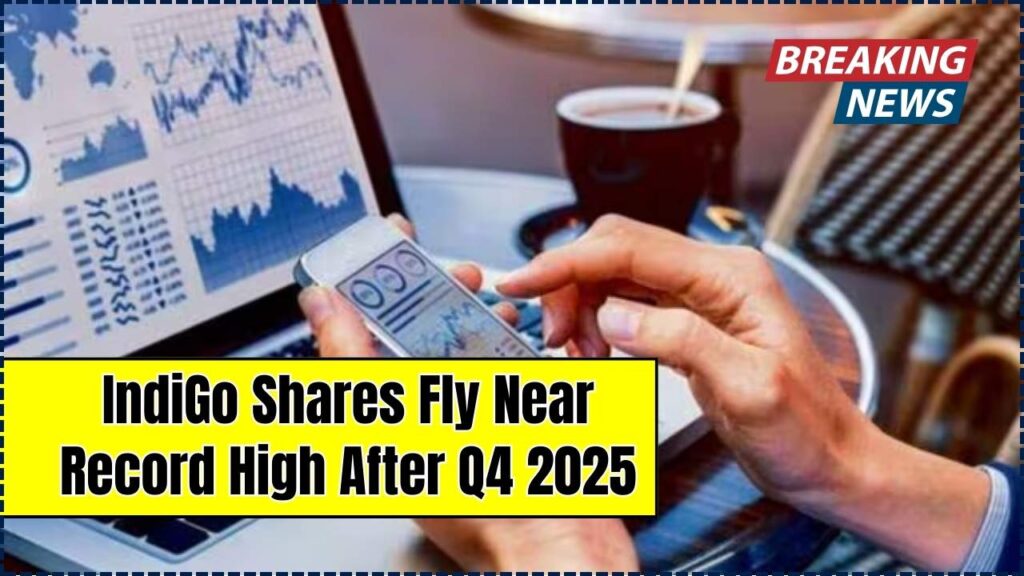IndiGo Shares Fly Near Record High After Q4: IndiGo’s stock is soaring, and it’s easy to see why. InterGlobe Aviation, the parent company of India’s largest airline, recently reported a 62% year-on-year jump in net profit for Q4 FY25, sending its shares close to an all-time high. As investors and aviation enthusiasts look at the numbers, one big question arises: Should you invest in IndiGo now, or wait for turbulence to settle?

In this article, we break down the latest results, expert views, risks, and rewards to help you make a confident, well-informed decision.
IndiGo Shares Fly Near Record High After Q4
| Metric/Insight | Details |
|---|---|
| Q4 FY25 Net Profit | ₹3,067 crore (up 62% YoY) |
| Revenue from Operations | ₹22,152 crore (up 24% YoY) |
| EBITDAR Margin | 31.4% |
| Share Price (Post-Q4) | Trading near ₹5,510 (May 22, 2025) |
| Record High | ₹5,650 |
| Target Prices by Analysts | Motilal Oswal: ₹6,375 |
| Dividend Declared | ₹10 per share |
| Growth Drivers | Passenger traffic, international routes, fleet expansion |
| Key Risks | Crude oil prices, aircraft delivery delays, FX volatility |
| Official Site | https://www.goindigo.in |
IndiGo’s latest financials showcase why it’s India’s aviation market leader. The airline’s focused strategy, aggressive expansion, and strong financials make it an appealing investment. However, potential risks—especially from macroeconomic factors—should not be overlooked.
As with any stock, do your research and consider your risk tolerance. IndiGo may be flying high, but smart investors always carry a parachute.
Q4 FY25 Performance: Why IndiGo Shares Are Climbing
IndiGo’s Q4 FY25 earnings have left a strong impression on investors. The airline reported a net profit of ₹3,067 crore, marking a 62% increase from the same quarter last year. Revenue from operations stood at ₹22,152 crore, up 24% YoY. Most notably, the EBITDAR margin improved to 31.4%, reflecting tight cost control and higher passenger load factors.
This performance makes Q4 FY25 one of the best quarters in the company’s history, despite headwinds in fuel prices and global supply chains.
What’s Fueling IndiGo’s Growth?
1. Fleet Expansion
IndiGo added multiple new aircraft to its fleet during FY25, including more fuel-efficient Airbus A321neos. This not only improves cost-per-seat metrics but also enables better reach across long-haul routes.
2. International Expansion
The airline has aggressively expanded its international network, now flying to over 30 international destinations. New routes to Southeast Asia and the Middle East have bolstered revenue.
3. Passenger Demand
Domestic air travel has seen a robust recovery post-pandemic, with a strong uptick in both leisure and business segments.
4. Cost Optimization
From fuel hedging to digital check-in systems and lean staffing models, IndiGo has optimized costs without compromising service.
Broker Views: What Experts Are Saying
Motilal Oswal
Maintains a ‘Buy’ rating with a target price of ₹6,375.
“Strong quarterly performance, expanding market share, and robust forward bookings support long-term outlook.”
Emkay Global
Gives a ‘Buy’ call with a target price of ₹6,000.
“IndiGo’s ability to leverage scale and cost leadership makes it the most profitable airline in India.”
ICICI Securities
Cautiously optimistic, citing the need to watch aircraft delivery timelines and fuel price trends.
Risks to Consider Before Investing
Even as IndiGo’s fundamentals look solid, no investment is without risks. Here’s what to keep in mind:
1. Crude Oil Prices
Jet fuel is a major operational cost. Spikes in crude oil prices can quickly erode margins.
2. Aircraft Delivery Delays
Global supply chain issues could delay fleet expansion, impacting capacity planning.
3. Foreign Exchange Volatility
Aircraft leasing and fuel purchases are often dollar-denominated. Rupee depreciation could increase costs.
4. Geopolitical Events
Tensions in international airspace or new visa rules can hurt international travel demand.
Investing in Airline Stocks: A Quick Guide
For those new to airline stocks, here are some important tips:
Watch Load Factors
Load factor = passengers carried ÷ available seats. A higher load factor usually means better profitability.
Track Crude Oil Trends
Oil prices directly affect profitability. Use sites like OilPrice.com to monitor trends.
Check Debt Levels
Airlines often have high debt. IndiGo maintains a relatively low net debt position—an important plus.
Focus on Market Share
IndiGo currently holds over 60% of India’s domestic market share, making it a dominant player.
Look at Long-Term Trends
Aviation is cyclical. While short-term headwinds exist, long-term demand in India remains strong.
Should You Buy IndiGo Shares Now?
The decision depends on your investment goals and risk appetite:
If You’re a Long-Term Investor:
IndiGo’s strong balance sheet, market leadership, and growth trajectory make it a compelling long-term bet.
If You’re a Short-Term Trader:
Wait for a possible dip or correction, especially as the stock nears its all-time high.
Pro Tip:
Watch upcoming earnings reports, international traffic data, and oil price fluctuations to time your entry better.
FAQs On
Q1: What caused IndiGo’s recent stock surge?
A: Strong Q4 results with a 62% profit jump and upbeat growth outlook.
Q2: Is IndiGo paying a dividend?
A: Yes, ₹10 per share for FY25.
Q3: Is it safe to invest in airline stocks?
A: It depends on your risk profile. Airline stocks are cyclical but can offer strong returns during upcycles.
Q4: Does IndiGo have any competitors?
A: SpiceJet, Akasa Air, Air India, and Vistara are key competitors in India.
Q5: How does IndiGo manage costs?
A: By maintaining a lean fleet, efficient crew utilization, and hedging fuel prices.







